Cordyline australis
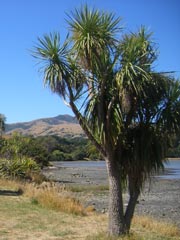
Cabbage trees grow all over New Zealand in a range of habitats from coastal areas through to inland foothills. They particularly favour the alluvial soils of flood plains, swamps and lakesides where they like growing in full sunlight.
As tī kōuka grow old and stems die, shoots can grow from the trunk. When this happens they can form a grove of trees. Tī kōuka can grow up to 20 metres in height, with tufts of long, sword–like leaves up to a metre long. They produce white, sweetly scented flowers in late spring and fruit in late summer with a small, whitish berry. The fruit is popular with birds such as korimako (bellbird), tui and kererū (wood pigeon), and latterly introduced birds. The trunk of the cabbage tree resembles cork with a spongy yet tough texture. During the years of settlement, they were often used to line the chimney space on early dwellings as they were quite fire resistant.
How Tī Kōuka was used by Māori
The cabbage tree was a significant food source for early Māori and provided a fibre resource prized for its strength. Māori lived in their pā where whānau groupings were the basic economic unit for supporting their way of life. Each group was allocated an area where they would be able to harvest the resources available from the lakes, rivers, coastlines and forests in their local takiwā(area). Each whānau or pā would have designated places where tī kōuka grew and was available to be harvested for food resources.
Tī Kauru (Food)
A good stand of tī Kōuka trees was commonly known as a para–kauru, with kauru being the name given to the food that is processed from the cabbage tree. Sometimes these para were just a collection of trees, but they may also have been treated as a regular area to harvest the kauru.
Each year there was a regular season for kauru which went from November through to March. After a first cut in November, there was still time for a second cut and cook session before the onset of winter in March.
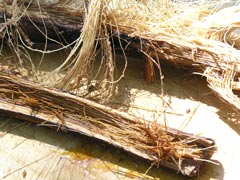
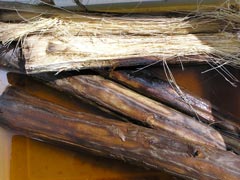
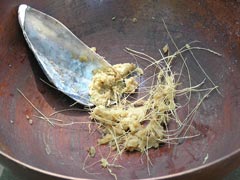
In November the trees were cut. This involved using a toki (axe) to cut the trees about a foot above the ground so that the trees could be re-cut again after a time of recovery. Each log about four feet long was cut in two, cleaned and left to dry for a month packed into large kete (baskets) made of Tī leaves, which could each hold fifty or sixty trunks.
By December or January they were ready for the cooking phase. The hangi or umu (oven) was huge, a square shape up to 20 metres in length. Fire was used to heat the stones to a good temperature, then the embers were removed and water added to the stones to make steam. The large baskets were then layered in the huge oven, covered with more leaves and earth to keep the heat in and then steamed for twenty–four hours. Today, the town of Temuka or more correctly “Te Umu Kaha” bears the name of one of these large ovens, a testament to the importance of this food for Ngāi Tahu Māori.
After drying the logs where they were cooked, the kauru supplies would then be carried in baskets to nearby pā for long–term storage. Luckily, the kauru logs became lighter after the cooking process. Kaiapoi Pā, the large pā established by Tūrakautahi was a key centre where kauru was traded for other mahinga kai resources brought in from key areas such as Rapaki and Taumutu.
The kauru was beaten on a flat stone to prepare for storing, then strung in pairs in a whata (drying rack). Storage whata were used to keep the kauru dry until ready for eating. At this final stage, the kauru was soaked and twisted to separate the fibre from the porridge called waitau kauru. It was sweet to taste and often mixed with berries or flax honey to enhance the flavour.
Local Mahinga Kai aficionado Karl Russell, explores the taste, texture and appeal of this once staple of the local diet in this video produced by Te Rūnanga o Ngāi Tahu.
Taproot
The other part of the tī kōuka that was used for food was the taproot. It was shaped like a 2 to 3 foot long carrot. Harvesting of the taproot was done during the flowering season when the saccharine (sugar) content in the root was at its highest.
Unfortunately, harvesting the taproot resulted in the loss of the tī kōuka tree. Teone Taare Tikao of Rapaki, an informant of 19th century commentators such as Herries Beattie and Edward Shortland, stated that the taproot was roasted in the coals of a fire rather than steamed. It was then beaten to separate the fibre from the meal. This porridge meal was often eaten with flax honey and berries.
Tikao mentioned the importance of observing correct procedures (tikanga) during the kauru process to ensure that the food was well cooked. As with other foods gathered, the first tree cut was kept as an offering to the gods to ensure that everything went well with the cooking process.
Raranga (Fibre)
Tī kōuka proved a useful source of fibre for early Māori. It was strong, durable, did not shrink in water and was used for making a range of daily items.
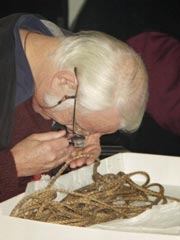
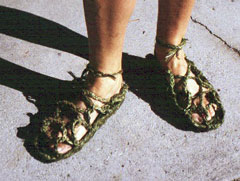
- Fishing
- Haika (anchor) ropes and kupenga (fishing lines) were constructed of tī kōuka which were especially good in seawater.
- Food
- Kete (baskets) were made for collecting and storing food and cooking mats for preparing food on.
- Clothing
- Paraerae (sandals), kakahū (cloaks) and pake (waterproof rain capes) are just some of the clothing items that were made with tī kōuka. A great deal of work was involved in collecting and preparing the fibre. It is hard for us to imagine what it was like to live in the South Island in those times, especially when we consider that all garments to keep people warm during winter would have to be made from flax or cabbage tree plants. When early Ngāi Tahu set off on a long hikoi (trek) to Tai Poutini on the West Coast for pounamu, they would need to make many pairs of paraerae that were carried along with the walkers. When these sandals were no longer useful, new ones would have to be made before the walkers could set off again on their journey.
Rongoa (Medicine)
Tī kōuka (Cordyline australis) was used to make a range of medicinal treatments:
- It was pounded into a paste.
- Growing tip (kōata) was eaten raw as a blood tonic or cleanser.
- Leaves provided juice used externally for cuts, cracks and sores.
- Infusions prepared by boiling leaves were drunk to treat diarrhoea.
- Leaves rubbed until soft were applied as an ointment to cuts, skin cracks and sore hands.
- Nursing mothers chewed the young shoots and gave them to their children for colic.
- Shoots were boiled and the liquid taken to treat stomach pains.
- Seeds have been shown to be high in linoleic acid — an essential fatty acid.
Acknowledgements
Images of Tī kōuka on this page are reproduced with kind permission of Sue Scheele, Landcare Research.
Related pages
References
- Which Native Tree? — A Simple Guide to the Identification of New Zealand Native Trees, Andrew Crowe, Penguin Books, Auckland 2004.
- Native Forests and Trees, Gordon Ell, The Bush Press, Auckland 2003.
- Tikao Talks — Traditions and Tales of the Canterbury Maoris as told by Teone Taare Tikao to Herries Beattie, Cadsonbury Publications, Christchurch 2004.
- Traditional Lifeways of the Southern Māori, James Herries Beattie, edited by Atholl Anderson. Otago University Press in association with Otago Museum, Dunedin 2009.
- Cabbage tree / ti kouka Department of Conservation.
- Ti Kouka entry in the Landcare Research Maori Plant Use database.
- Maori Agriculture Elsdon Best in The Journal of the Polynesian Society, Vol 40 , No. 157, 1931, pages 1 – 22
- The 2006 Banks Memorial Lecture: Cultural uses of New Zealand native plants Sue Scheele in New Zealand Garden Journal, 2007, Vol. 10(2), p. 10 – 16.
- Cabbage tree, ti Alec Lindsay Poole article in the 1966 An Encyclopaedia of New Zealand, edited by A. H. McLintock.
- Pake style of cloak Topic page from Te Papa.
- Paraerae (sandals) Jock Phillips, Walking tracks – Māori highways, Te Ara the encyclopedia of New Zealand.
- Sandals: Paraerae Transactions and Proceedings of the Royal Society of New Zealand, Volume 55, 1924, p. 357 – 360.
- Cabbage tree kete Joanna Orwin, Shrubs and small trees of the forest – Cabbage trees, Te Ara the encyclopedia of New Zealand.
- Cabbage tree DigitalNZ images and articles.
